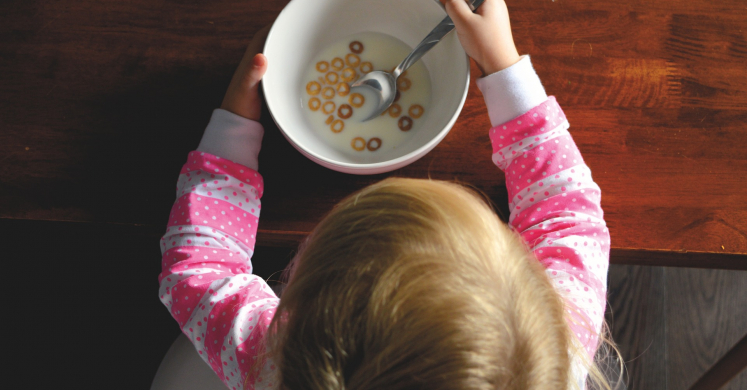Blog

Toddler Nutrition with Let’s Move Pittsburgh
From balancing serving sizes to managing mealtime messiness, feeding the little ones can be fun, exciting, chaotic, and stressful (sometimes all at once!). Watch this webinar to learn about the nutrient needs for your toddler's growing body.
Toddler Nutrition Webinar
Class Materials: Toddler Nutrition PowerPoint, Feeding and Nutrition Tips: 1 Year Old, Feeding and Nutrition Tips: 2 Years Old, Feeding and Nutrition Tips: 3 Years Old
FAQS:
Are there specific nutrients I should be mindful of when feeding my toddler?
Toddler nutrient concerns are a case-by-case basis. This being said, two nutrient deficiencies that are the most common amongst toddlers are iron and vitamin D. Toddlers who drink too much milk are at risk for iron deficiency. Excessive milk intake interferes with the body's ability to absorb iron from food and supplements due to it’s high calcium content (calcium and iron compete for absorption). Additionally, if our children fill up on milk, which is naturally low in iron, they are missing that iron source from other food sources. So how much milk is too much? Try to aim under 32 oz (4 cups) for toddlers. The American Academy of Pediatrics recommends 2-3 servings of dairy or dairy alternative per day. One serving is 1/2 cup milk or soy milk, 1/2 ounce (1 inch cube) cheese, 2 tablespoons shredded cheese, or 1/3 cup yogurt/soy yogurt. For my plant-based/dairy-free folks, products made from soy or peas have the closest nutritional value to cow's milk, and are ideal alternatives.
Vitamin D is a tricky nutrient to get enough of for all ages. Vitamin D is especially important for toddlers and children because it helps the body absorb calcium and phosphate from food, which is essential for bone strength and growth. Most vitamin D is made in the skin when it is exposed to sunlight. Research on vitamin D suggests that approximately five to 30 minutes of sun exposure on the face, arms, legs, or back without sunscreen between 10 am and 3 pm at least twice per week usually leads to sufficient vitamin D synthesis.1,2,3 Vitamin D can be found in foods, but doesn't occur naturally in many. Fatty fish (e.g. salmon and tuna), mushrooms exposed to UV light (synthetic or natural) and fortified foods are all great vitamin D food sources.
What if my toddler doesn’t want to eat the foods I’ve served? I’m worried that they aren’t eating enough.
I answered this question in my Mealtime Positivity webinar, but I’m including it in this post as well since it’s my most common toddler-related question. I hope to provide reassurance that “picky eating” is normal toddler behavior! Many toddlers express their growing independence through eating, which results in mealtime fussiness. Instead of pressuring your child to eat more than they want to, practice telling yourself, “that’s all their body needs right now” and let it go. In fact, research suggests that excessive mealtime pressure is associated with childhood picky eating.4 Children are strong intuitive eaters, and you have to trust that they know their appetite best. If your child has healthy growth trends, then they are meeting their needs.
Do you have any favorite toddler nutrition resources?
I’ve been really into child nutrition instagram posts lately. I’m a visual learner and I find the picture-based education posts to be super helpful. Here are a few of my go-to instagram account recommendations:
Instagram Accounts:
If you don’t have an instagram account and/or are looking for toddler food and nutrition websites, check these out:
- https://www.mjandhungryman.com/
- https://www.superkidsnutrition.com/
- https://mylittleeater.com/
- https://www.ellynsatterinstitute.org/
Sources:
- Holick MF. Vitamin D deficiency. N Engl J Med 2007;357:266-81. [PubMed abstract]
- Bouillon R. Comparative analysis of nutritional guidelines for vitamin D. Nat Rev Endocrinol 2017;13:466-79.
- U.S. Department of Health and Human Services. The Surgeon General’s Call to Action to Prevent Skin Cancerexternal link disclaimer. Washington, DC: U.S. Dept of Health and Human Services, Office of the Surgeon General; 2014.
- Sanders, Matthew & Patel, Rinu & Grice, Bonny & Shepherd, Ross. (1993). Children With Persistent Feeding Difficulties: An Observational Analysis of the Feeding Interactions of Problem and Non-Problem Eaters. Health psychology : official journal of the Division of Health Psychology, American Psychological Association. 12. 64-73. 10.1037/0278-6133.12.1.64.

